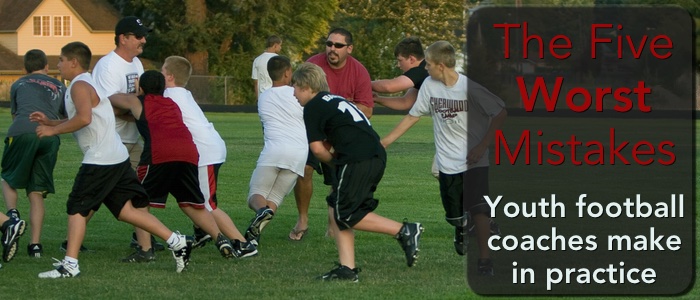The 5 Worst Mistakes Youth Football Coaches Make in Practice

I’ve been around a lot of youth football practices over the past 12 years, and it still dismays me to see the same mistakes made over and over. These are easily correctable, though my suspicion is that these coaches probably aren’t the type that spend time in the off-season improving their approach.
These mistakes are specifically about practice, and I could probably make similar lists about season planning and game planning.
- Not having a plan – Showing up to practice and winging it, including telling assistant coaches to just drill their position groups. Not having a plan also often leads to the corollary problem #4 below. The result will be unfocused practices without specific goals in mind, drills that run too long, and players doing activities for activity sake. Instead, plan each practice with an objective tied to the weekly objectives you and your other coaches defined. Schedule the plan to the minute, but have an understanding with your assistant coaches that you may alter the script at times.
- Talking through drills instead of showing and repping – It is ok to talk to your players when introducing a new drill, but think ahead of time about how you will quickly explain and demonstrate the drill, then get into your repetitions. The players will flip a switch on you quickly if you start to drone or over-explain. Instead, it is better to talk a bit less then get into reps where you can make small corrections as you go.
- Having long lines of kids waiting for drill reps – This might seem unavoidable if you have a shallow coaching staff of just 2 or 3 with 25 or more players. There are alternatives you can consider. If you have 5 or more coaches, there’s no excuse to have kids standing around in practice waiting for their chance to participate. With no more than 6 players per coach, and with properly run drills you can keep the players fully engaged. What if you have a coach shortage? Run multiple lines / groups at the same time, either staggered one behind the other, or in a circle or square around you so you can observe. Rotate the kids around the square so that you can focus on one particular group to give small bits of feedback. This will at least double the reps for each player, and still allow you to observe.
- Scrimmaging as the default – Maybe you’ve seen this practice schedule put together (or improvised) by a youth coach:
- 15 minutes – wait for stragglers, static stretching, dynamic warm ups
- 30 minutes – position specific drills
- 60 minutes – team / scrimmage period
- 15 minutes – conditioning (gassers and up-downs)
This is a practice plan without a purpose, that wastes time, will not allow for enough position specific coaching, and will likely lead to high injury occurrence. Players definitely need team, scrimmage, and full contact time in practice, particularly pre-season leading to first game and likely into the first two to three weeks in season. But 45 or more minutes of scrimmage in a practice takes away the more intimate coach-on-player interaction required for specific improvement to take place. Even if you have good coaches that can watch their position groups (most just watch the ball), they probably aren’t very good at coaching on the run so are likely to shut down the entire scrimmage while they correct a missed blocking assignment, or talk to the QB about footwork, etc. That means about 95% of the players are standing around, likely beginning to goof off, while a single player or maybe 2 or 3 get some coaching.
Years ago we used to do team-on-team scrimmages within our association. Our league is structured so that teams from the same association will never play each other, so these scrimmages were the only time the Sherwood “red” team would get to play the “black” team. Do you think the players got amped up for these scrimmages against their buddies? You better believe it, and I think we had higher injury occurrence in these scrimmages than we had n regular games. About 6 years ago we stopped doing these, sometimes upsetting other coaches with our reluctance.
- Excessive conditioning and contact – Maybe one advantage I have over other coaches that played a lot of football growing up is that I’m less influenced by “old school” coaching supposed truths. Players need to get into game shape and be ready for the brutal contact required in this support. But why would you spend any part of your precious six hours per week on running lines or doing push-ups when you could achieve similar conditioning results while teaching football skills? Instead of running lines, run a punt coverage drill, or a kickoff coverage drill with block shedding, or run plays on air.I think the jury is still out on what level of contact is required for success. My belief is it depends greatly on the experience and age of the players. Regardless, coaches should be intentional about what level of contact they are striving for in a particular drill, and they should work the kids through a progression to gradually get them more comfortable with contact and safe ways to tackle and block. This is one reason I love the Hawk tackling progression as we can easily work on form and approach without pads during early camp sessions.
That’s my list. Fortunately, more and more coaches are getting educated and applying more common sense to how they approach practice organization and technique.